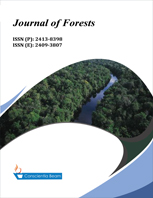Urban forestry for sustainable urban management: A study from Hetauda Sub-metropolitan City, Nepal
DOI:
https://doi.org/10.18488/jof.v12i1.4074Abstract
Developing sustainable urban areas in such a way that every citizens can enjoy a high quality of life and environment is one of the pressing environmental challenges we face today. This study was conducted to identify the major urban tree species and people’s perceptions towards urban forestry for sustainable urban development in Hetauda Sub-metropolitan City, Nepal. Mixed method of field assessment and questionnaire survey with urban households (N=125) was used to collect information regarding urban forestry by applying simple random sampling. Data were analyzed using descriptive and Likert scale rating through SPSS. The results showed that 46 different tree species were recorded in the study area with most frequent being Saraca asoca, Mangifera indica and Ficus religiosa. Based on local people’s preference Sparaco asoca, Nyctanthes arbortristis, and Thusa spp. are top 3 species for urban plantation. People opined that management of urban forest is not so good and they responded that poor management of roadside trees is due to lack of people participation with weighted mean value of 2.10. More than 90% of the respondents agreed that urban trees are essential for sustainable urban planning. Furthermore, rapid urbanization, lack of public awareness, and limited institutional support are major challenges while community engagement, ecological resilience, and government initiatives and policies are major opportunities for urban forestry development in the city. Therefore, appropriate selection of tree species, community participation and awareness regarding urban forestry should be emphasized. Furthermore, urban forestry program requires its prioritization and integration in the local and national policies.

